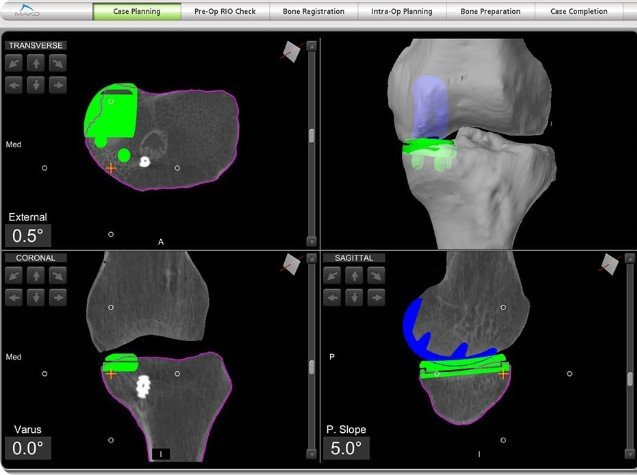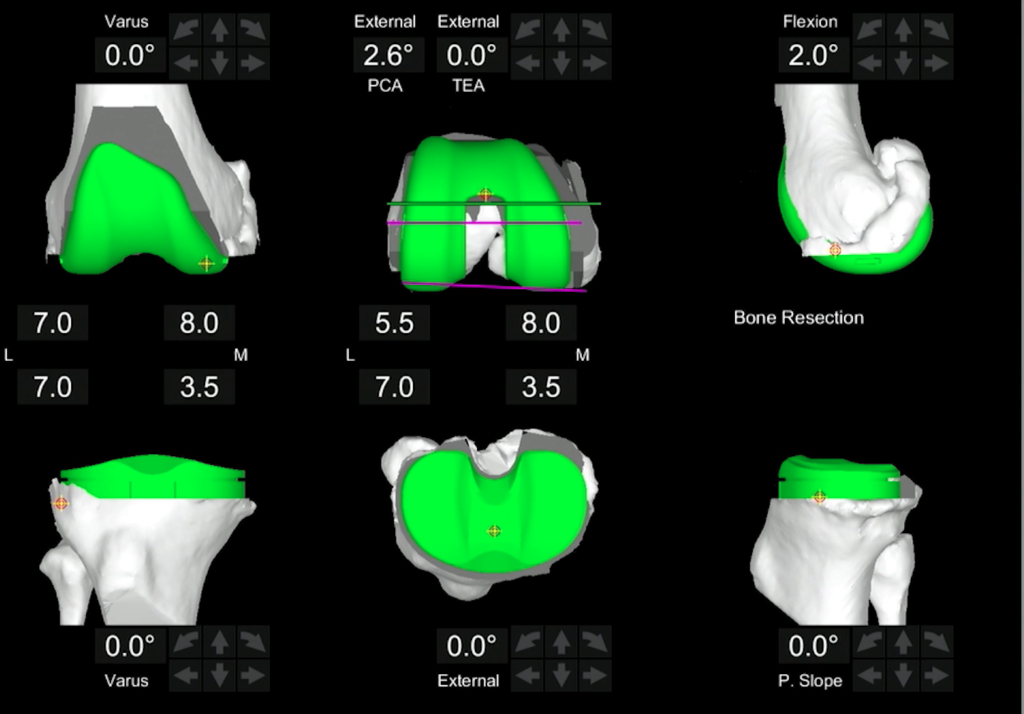Robotics
CORI Surgical System
CORI is a robotics-assisted knee surgery platform that adds an extra layer of pre-surgical planning and improved accuracy for partial and total knee replacement procedures.
Your knee replacement surgery thus becomes unique, based on your knee anatomy and the implant used. CORI is designed to help ensure your knee replacement is positioned and aligned correctly as that is a crucial factor in determining how long your implant may last.

The latest innovation in knee replacement surgery
Surgical techniques have evolved considerably since the earliest knee implant procedures were performed in 1968. These procedures relied on manual guides, external pins and cutting jigs to remove damaged bone and place the prosthetic implant.
Eventually more advanced implant positioning techniques were introduced that used long rods drilled into the central canal of the femur (thigh bone). These rods provide an attachment point for surgical cutting guides. More recent improvements introduced CT scan/MRI image guidance to create an individualized computer-generated surgical plan for each patient.
The latest innovation is the CORI Surgical System, a robotics-assisted platform that uses CT-free technology for accurate implant sizing and positioning without the need for rods. The CORI Surgical System can be used for either a partial or total knee replacement procedure.
CORI system benefits: Accuracy, less exposure to CT radiation
The CORI system offers two important benefits for people undergoing a knee replacement procedure. First, it helps your surgeon create a highly individualised plan that is specific to the unique shape and motion of your knee. Traditional planning may require CT scans, a series of images similar to x-rays that shows cross-sections of your knee. While other robotic-assisted platforms require CT scans, the CORI system works without them, meaning you are not exposed to the potentially harmful radiation experienced with this type of imaging. The second benefit is Robotics assistance in execution of there surgery. This combination of advanced technology is designed to help your surgeon and may result in more accuracy, giving you better long-term outcomes.
The CORI system is used for both partial and total knee replacement, which are distinctly different procedures. Here’s a bit more information on how the NAVIO system is used in these surgeries:
Partial Knee Replacement/Resurfacing
In total knee replacement surgery, the entire knee joint is replaced with a prosthetic implant designed to replicate the shape, motion and stability of your natural knee joint. Total knee replacement is one of the most common procedures performed in all of medicine. Ninety percent of people who receive a total knee replacement experience a dramatic decrease in knee pain, and an improvement in their ability to perform daily activities.
Robotics-assisted planning and Partial/Total Knee Resurfacing
Using the CORI system, we create a 3D representation of the unique shape and profile of your knee without the need of a pre-operative CT scan. Using this information we can then determine the correct size and position of the implant. Implant size and position is critical to knee alignment and stability. Next, we use robotics assistance of CORI to physically remove only the damaged bone and cartilage, preparing the site for the prosthesis, before placing and adjusting your final knee implant.
For people suffering from knee pain caused by osteoarthritis, whose damage is limited to a single compartment or area of the knee, partial knee replacement may be an option because it preserves healthy bone and ligaments while replacing the damaged area. The NAVIO Surgical System uses robotics-assisted technology to help tailor partial knee replacement procedures to the unique shape and motion of each patient’s knee anatomy.
Robotics-assisted planning for better surgical outcome

While it may seem counterintuitive, replacing only part of a knee joint can be more challenging than replacing the entire joint. This is because partial knee replacement must achieve an exact balance between the new implant – made of metal and plastic components – and the remaining portions of your natural anatomy made of bone and cartilage. As a result, one of the primary challenges of all partial knee replacements is precisely positioning the implant for each unique patient. Even minor changes in an implant’s size or placement can cause the knee to function poorly or result in early failure of the implant and the need for future surgery.
The NAVIO Surgical System addresses the challenge of partial knee replacement by using both computer and robotic assistance to accurately map the surface of your knee, align your implant to your anatomy, and physically remove the bone necessary to place your new implant.3 This added level of assistance is important because implant alignment is a crucial factor in determining how long the implant will last.
Robotic knee surgery without radiation
Other robotic knee replacement systems use computerized tomography, or CT, scans to help a surgeon visualize a patient’s knee anatomy. While CT scans are effective at showing the layers of knee anatomy, they can expose the patient to potentially harmful radiation. In fact, a single CT scan is equivalent to the radiation exposure received in 48 chest X-rays.
The NAVIO system eliminates the need for CT scans by using an advanced computer program (similar to GPS navigation on your phone) to collect anatomic and alignment information about your knee.

Once captured, this information is used to build a precise, computer-rendered 3D model of your knee that your surgeon will use to plan your surgery.
NAVIO Robotics-assisted partial knee replacement surgery
After all of the information about your knee is gathered and your surgical plan is created, your surgeon will use a robotics-assisted surgical tool (the NAVIO handpiece) to physically remove the damaged surface of your bone so that your new implant fits properly. Using the same 3D model of your knee, the handpiece is able to differentiate between the damaged areas that need to be removed, and the healthy areas that will remain. The NAVIO handpiece uses a burr that removes damaged bone for your implant.

The NAVIO system doesn’t replace your surgeon. Rather, it assists your surgeon by adding an extra layer of planning to the procedure.
Partial knee replacement with traditional techniques
By comparison, traditional surgical methods for partial knee replacement use mechanical cutting guides that help guide a saw blade as it removes the bone necessary to place the implant. The NAVIO Surgical System helps tailor your partial knee replacement procedure.
Important safety notes
Individual results of joint replacement vary. Implants are intended to relieve knee pain and improve function, but may not produce the same feel or function as your original knee. There are potential risks with knee replacement surgery such as loosening, wear and infection that may result in the need for additional surgery. Patients should not perform high impact activities such as running and jumping unless their surgeon tells them that the bone has healed and these activities are acceptable. Early device failure, breakage or loosening may occur if a surgeon’s limitations on activity level are not followed.
Disclaimer
Individual results may vary. There are risks associated with any surgical procedure including NAVIO-enabled Knee Replacement. NAVIO is not for everyone. Children, pregnant women, patients who have mental or neuromuscular disorders that do not allow control of the knee joint, morbidly obese patients, or any other patients contraindicated for UKR, PFA, or TKA should not undergo a NAVIO procedure. Consult your physician for details to determine if NAVIO is right for you.
More than 600,000 total knee replacement procedures are performed each year in the U.S. and more than 90% of these patients experience a dramatic relief in knee pain and are better able to perform common activites. The NAVIO◊ Surgical System delivers robotics-assisted tools designed to help tailor your total knee replacement surgery to the unique shape and motion of your knee.
Robotics-assisted knee replacement planning with the NAVIO System

The total knee replacement procedure starts with your unique anatomy in mind. By the time your procedure is complete, the damaged bones and cartilage within your knee joint will be removed and replaced with new implant components. Each of these implant components must fit precisely and be aligned to your natural anatomy if they are to provide you with the best outcome possible. The challenge of aligning your implant and preparing your bones to accept it can be complex, invasive and time consuming because no two knee joints are exactly the same.
The NAVIO Surgical System is designed to help your surgeon not only plan your surgery based on your unique anatomy, but also position your total knee implant using a combination of computer and robotic assistance. The NAVIO procedure starts with an advanced computer system that gathers precise anatomic and alignment information about your joint that your surgeon will use to create your specific surgical plan.
This extra layer of data collection and planning is designed to help ensure your knee procedure is performed exactly as your surgeon intends and that your implant is positioned as accurately as possible for the best long-term outcome.
CT-free
Other robotic-assisted knee replacement systems use computerized tomography, or CT, scans to help a surgeon visualize a patient’s knee anatomy. While CT scans are effective at showing the layers of knee anatomy, they can expose the patient to potentially harmful radiation. In fact, a single CT scan is equivalent to the radiation exposure received in 48 chest X-rays.
The NAVIO system eliminates the need for CT scans by using an advanced computer program to collect anatomic and alignment information about your knee. Once captured, this information is used to build a precise, computer-rendered 3D model of your knee that your surgeon will use to plan your surgery.

Total knee replacement surgery without rods
Another method that can be used to determine the anatomic alignment of your new implants uses long, metal devices called intramedullary (IM) rods that are drilled into the central canal of the bone to show the alignment of the knee in relation to the hip. These rods are then used to attach the cutting guides necessary to guide the surgeon’s saw blade as it shapes the bones to accept the new implants.
Because the NAVIO system has already gathered the anatomic alignment information about your knee, it eliminates the need for IM rods. Instead, your surgeon will use the system’s handheld robotics-assisted tool (the NAVIO handpiece) to accurately position the NAVIO-specific cut guides which are held in place with a few small pins instead of the IM rod. This process leaves the central canal of your bone untouched. Implant alignment is a crucial factor in determining how long the implant will last .

NAVIO brings robotics-assisted precision to total knee surgery
After removing the cutting guides, the prosthetic knee implants are implanted and your knee is checked to make sure it moves and is balanced correctly. It is important to understand that the NAVIO system doesn’t replace your surgeon. The procedure remains in the skilled hands of your surgeon, with the NAVIO system providing extra layers of planning, accuracy and precision.
Important safety notes
Individual results of joint replacement vary. Implants are intended to relieve knee pain and improve function, but may not produce the same feel or function as your original knee. There are potential risks with knee replacement surgery such as loosening, wear and infection that may result in the need for additional surgery. Patients should not perform high impact activities such as running and jumping unless their surgeon tells them that the bone has healed and these activities are acceptable. Early device failure, breakage or loosening may occur if a surgeon’s limitations on activity level are not followed.
Disclaimer
Individual results may vary. There are risks associated with any surgical procedure including NAVIO-enabled Knee Replacement. NAVIO is not for everyone. Children, pregnant women, patients who have mental or neuromuscular disorders that do not allow control of the knee joint, and morbidly obese patients should not undergo a NAVIO procedure. Consult your physician for details to determine if NAVIO is right for you.
